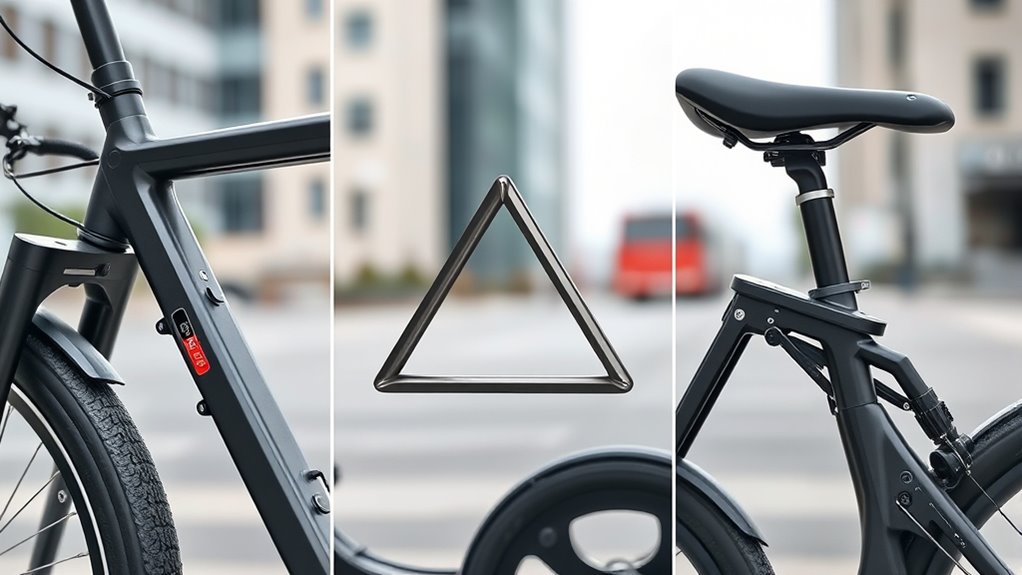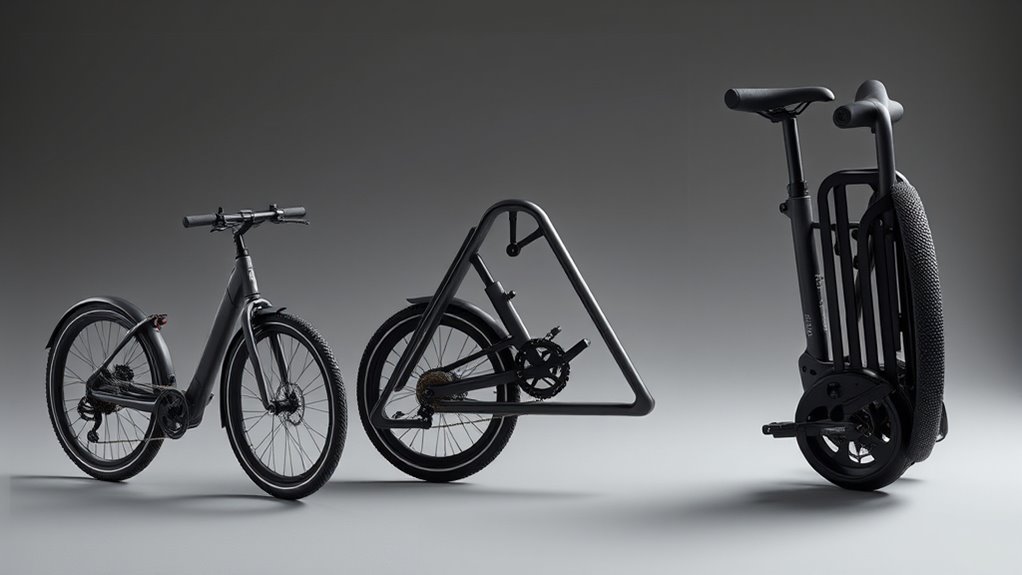Folding e-bikes use three main mechanisms: mid-hinge, triangle, and vertical folds. Mid-hinge bikes fold in the middle, offering a compact form while maintaining stability. Triangle folding bikes hinge near the seat post, creating a small, easy-to-carry shape. Vertical folds fold the bike up or down, resulting in a narrow profile ideal for storage. Each mechanism impacts how you handle and store the bike—discover more to find what suits your needs best.
Key Takeaways
- Mid-hinge folding bikes split the frame at the center, offering a good balance of compactness and stability.
- Triangle folding mechanisms fold near the seat post or frame, enabling smaller, more portable configurations.
- Vertical folding hinges allow the bike to fold vertically, creating a narrow profile for easier storage and transport.
- Each mechanism impacts hinge durability, battery placement, and overall ease of folding and unfolding.
- Proper design ensures hinges withstand repeated use and protect the battery from impacts and environmental elements.

Folding e-bike mechanisms are designed to make transportation more convenient by allowing you to easily collapse your bike for storage or transit. When choosing a folding e-bike, understanding how these mechanisms work can help you pick the right model for your needs. One of the key components to consider is battery placement. Some bikes have batteries integrated into the frame, which often sit near the hinge or folding joint. This placement can impact the bike’s overall balance and weight distribution, making it easier or harder to fold and carry. Proper battery placement also affects the bike’s center of gravity, guaranteeing a smoother ride once unfolded. Additionally, a well-designed battery compartment that’s protected from dust and moisture can extend the lifespan of your e-bike, especially if you frequently fold and unfold it. The choice of hinge type also influences how seamlessly the bike folds and unfolds, impacting overall usability.
Battery placement near hinges enhances balance, durability, and ease of folding in e-bike mechanisms.
Another essential aspect is hinge durability. The hinge is the primary point where the bike folds, so it needs to withstand repeated use without weakening or breaking. High-quality hinges often feature reinforced materials, such as steel or heavy-duty aluminum, that can endure daily folding and unfolding. Some models incorporate locking mechanisms that secure the frame in place when riding, preventing unwanted movement and adding to safety. The durability of these hinges directly influences the bike’s longevity and your confidence in its reliability. If hinges are flimsy or poorly constructed, they may loosen over time, leading to wobbling or even failure during rides. Consequently, investing in bikes with sturdy hinges is crucial to guarantee your folding e-bike remains safe and functional over the long term.
Mid-hinge folding mechanisms typically divide the bike into two sections, folding in the middle. This design is popular because it offers a compact fold while maintaining structural integrity. The hinge at the midpoint must be robust, with high-quality materials and secure locking mechanisms to prevent accidental unfolding. The placement of the battery often coincides with this hinge, so the design must account for protecting the battery from impacts and water ingress. Triangle folding mechanisms differ by folding at a joint near the seat post or frame, creating a triangular configuration when folded. This design can sometimes allow for a more compact fold and easier handling, but hinges need to be especially durable to handle the stress at these joints. Vertical folding mechanisms typically fold the bike vertically, often at the frame’s top tube or down tube, allowing for a tall, narrow profile. These hinges are often subjected to more stress, making hinge durability even more critical. Considering the projected lifespan of the hinge and battery placement can help ensure long-term satisfaction with your folding e-bike.
Ultimately, the effectiveness of a folding e-bike hinges and battery placement determines how easy it is to carry and how reliable it remains over time. Careful consideration of these factors guarantees your e-bike can handle daily use while remaining compact and portable when folded.
Frequently Asked Questions
How Durable Are Folding E-Bike Mechanisms Over Time?
Sure, your folding e-bike’s mechanism is practically indestructible—until it’s not. Over time, mechanism longevity depends on material durability and how often you fold and unfold. If you’re gentle, it’ll last longer; if you’re rough, expect squeaks and wobbles. Honestly, with quality materials and proper care, these mechanisms can endure years of daily use, proving that sometimes, a little extra TLC beats replacing your bike altogether.
What Maintenance Is Required for Different Folding Mechanisms?
You should regularly inspect your folding e-bike’s mechanism, keeping it clean and lubricated to guarantee smooth folding. Check the battery life to avoid sudden power loss, and perform tire maintenance like inflating tires to the correct pressure for maximum performance. For different folding mechanisms, tighten hinges and latches periodically, and replace worn parts promptly. Proper maintenance extends the life of your e-bike and keeps it safe and reliable on every ride.
Are Folding E-Bikes Suitable for All Terrains?
Folding e-bikes aren’t suitable for all terrains because their terrain adaptability varies. If you prefer smooth city streets, most models work well. However, if you like rugged trails or steep hills, you’ll need a bike with sturdy tires and a powerful motor. Your terrain preferences matter because they influence the bike’s performance and durability. Select a folding e-bike designed for your specific terrain to guarantee a smooth ride.
How Do Folding Mechanisms Impact Bike Weight and Portability?
Folding mechanisms influence your bike’s weight and portability considerably. Lightweight bike frame materials like aluminum or carbon fiber make folding easier and lighter, enhancing portability. The type of folding lock system also affects the overall weight; simpler systems tend to be lighter but may compromise security. When choosing a folding e-bike, consider how the mechanism integrates with these materials to guarantee it’s easy to carry and store without sacrificing durability.
Can Folding E-Bikes Be Customized With Accessories?
Absolutely, you can customize your folding e-bike with accessories! With smart battery integration, you can add extra lights, racks, or even a phone holder without sacrificing style or function. Most models support accessory compatibility, making it easy to personalize your ride for commuting, adventure, or daily errands. Just choose accessories designed for your bike’s frame and folding mechanism, and enjoy a tailored ride that fits your lifestyle perfectly.
Conclusion
Now that you’ve uncovered the secrets behind mid-hinge, triangle, and vertical fold mechanisms, you’re ready to choose the perfect e-bike for your adventures. Each fold is like a key to freedom, releasing convenience and portability whenever you need it. So, imagine yourself effortlessly gliding through city streets or tucked away in tight spaces—your perfect ride is just a fold away. Embrace the future of cycling—because the road to convenience begins with a simple fold.





